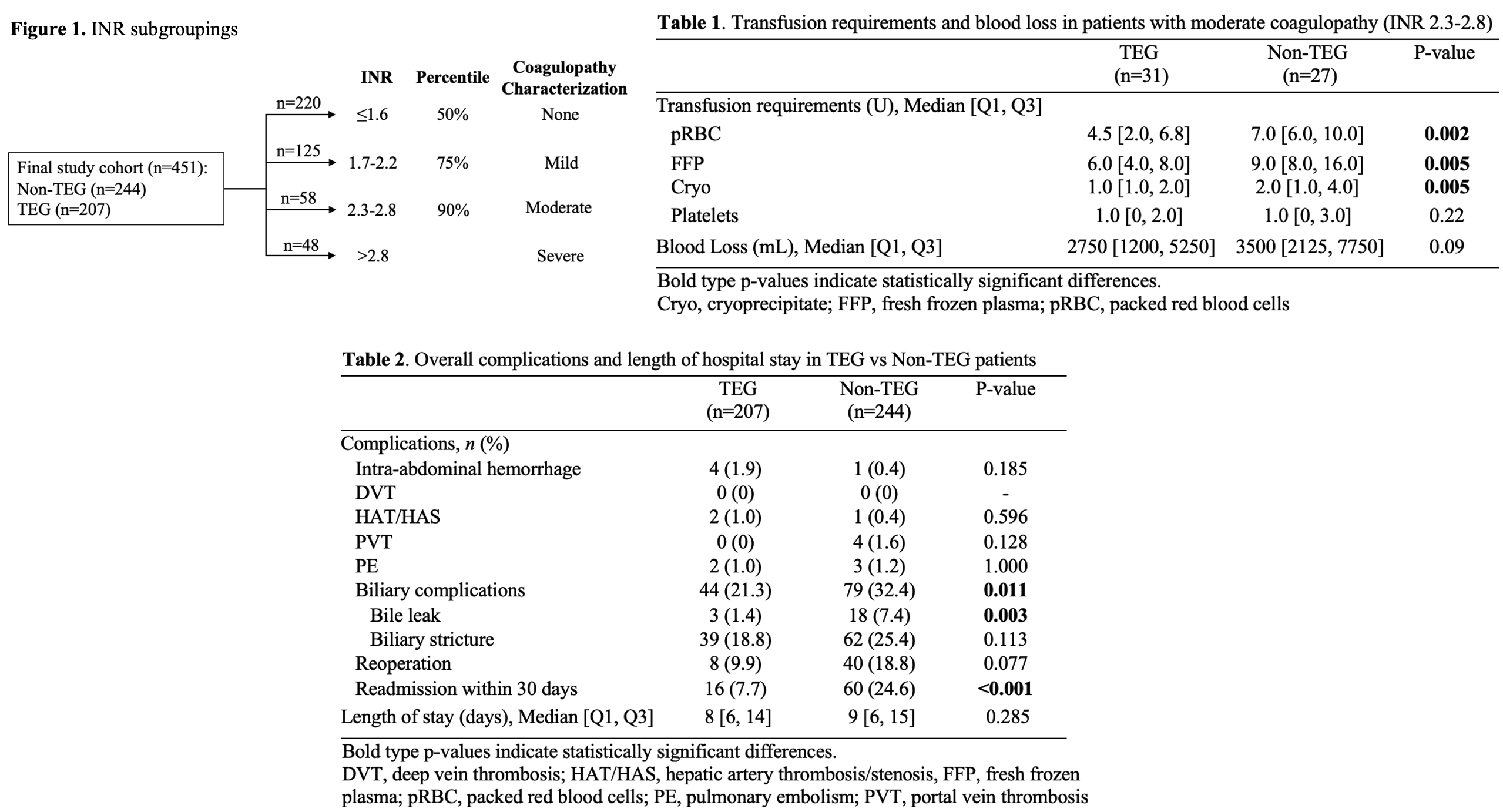Thromboelastography in Liver Transplantation: A Target Group
1Henry Ford Transplant Institute, Detroit, MI, 2Henry Ford Hospital, Detroit, MI, 3Surgery, Henry Ford Transplant Institute, Detroit, MI
Meeting: 2022 American Transplant Congress
Abstract number: 1510
Keywords: Liver transplantation, Outcome, Resource utilization
Topic: Clinical Science » Organ Inclusive » 71 - Surgical Issues (Open, Minimally Invasive):All Organs
Session Information
Session Name: Surgical Issues (Open, Minimally Invasive): All Organs
Session Type: Poster Abstract
Date: Monday, June 6, 2022
Session Time: 7:00pm-8:00pm
 Presentation Time: 7:00pm-8:00pm
Presentation Time: 7:00pm-8:00pm
Location: Hynes Halls C & D
*Purpose: Liver dysfunction results in derangement of hemostasis and thrombosis. Thromboelastography (TEG) has emerged as a tool to guide resuscitative efforts. However, its utilization and application in liver transplant (LT) surgery has not been established. We aim to identify possible effects of TEG utilization on product use, post-operative complications, and length of stay (LOS).
*Methods: Adult patients who received LT between 2014 and 2020 were retrospectively reviewed. Those patients who underwent living donor, simultaneous or multi-organ transplants, re-transplants, and recipients <18 years of age were excluded. Possible impact of TEG implementation on blood product use, pressor requirements, post-operative complications, and cost to patients was analyzed. A subgroup analysis was done based on INR at transplant. The median, 75th, and 90th percentile of INR at transplant were used as cut-off values and patients were classified into four categories: no coagulopathy (INR ≤1.6), mild (INR 1.7-2.2), moderate (INR 2.3-2.8), and severe coagulopathy (INR >2.8) (Figure 1).
*Results: A total of 451 patients met inclusion criteria and were separated into TEG (n=207) vs non-TEG (n=244) groups. Background characteristics between these two groups were comparable. Overall, no significant differences between transfusion requirements and blood loss were found between the two groups. In the subgroup analysis, there was a significant decrease in product use in the TEG group with moderate coagulopathy, compared to the non-TEG group (Table 1). When looking at complications, there was a significantly higher proportion of hospital readmissions and biliary complications in non-TEG patients (Table 2). Of the biliary complications, non-TEG patients developed more bile leaks. Although there is not a statistically significant difference in hospital length of stay, the median length of stay for non-TEG patients was 9 days whereas that of TEG patients was 8 days (Table 2).
*Conclusions: TEG guided hemostasis and resuscitation in LT resulted in a decrease in product usage in patients with moderate coagulopathy (INR 2.3-2.8). Refined product use may also contribute to decreased incidence of bile leaks.
To cite this abstract in AMA style:
Mohamed A, Kitajima T, Cui J, Angappan S, Delvecchio K, Shamaa T, Ivanics T, Shimada S, Rizzari M, Collins K, Yoshida A, Abouljoud M, El-Bashir J, Nagai S. Thromboelastography in Liver Transplantation: A Target Group [abstract]. Am J Transplant. 2022; 22 (suppl 3). https://atcmeetingabstracts.com/abstract/thromboelastography-in-liver-transplantation-a-target-group/. Accessed January 2, 2026.« Back to 2022 American Transplant Congress

